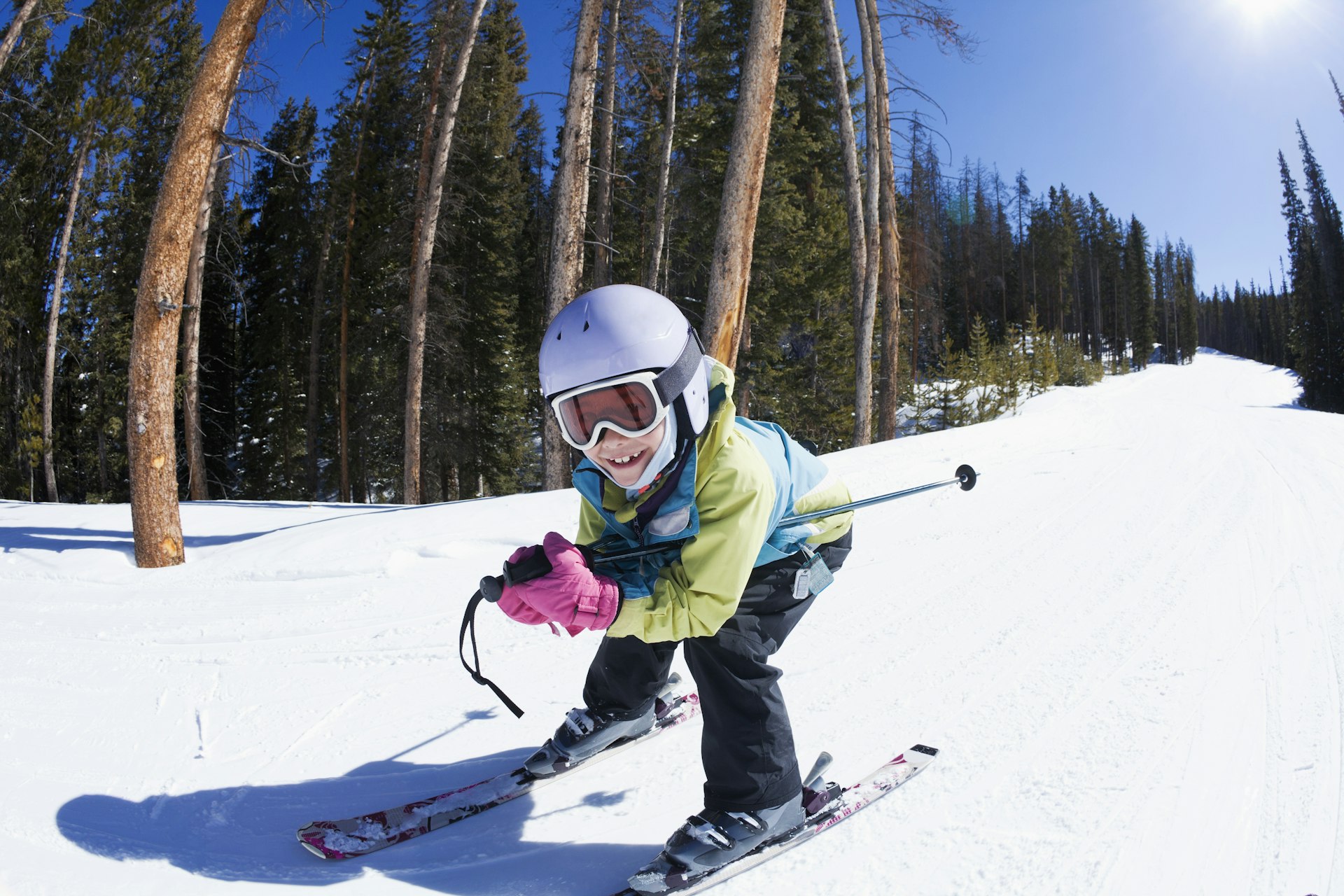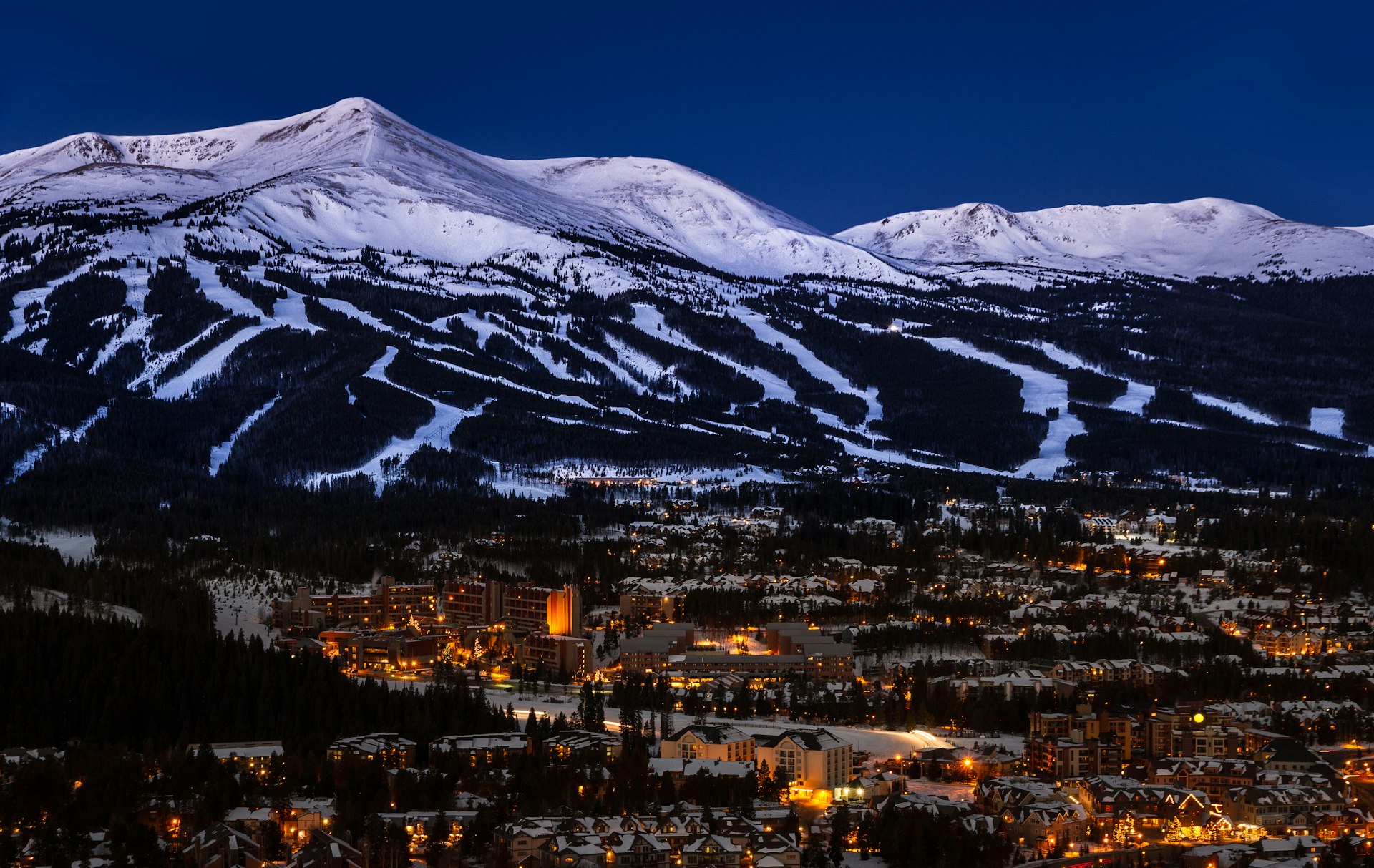The combination of champagne powder, endless blue skies, mammoth mountains and a live-to-ski ethos makes skiing in Colorado the stuff of legend. From cruisers and tree runs to back bowls and terrain parks, Colorado is one of the country’s best and most varied places to ski.
With more than 30 resorts to choose from, this state really does have a mountain – and ski town – for everyone.
1. Vail
Best luxury resort
Vail oozes mountain luxury, with second-to-none slopes and a glitzy village to match. The hill spans more than 5200 acres and is truly a paradise of silky corduroy and spacious back bowls, including the legendary Blue Sky Basin.
When the lifts close, mountainside glam awaits in Vail’s Bavarian-themed village with twinkling lights and heated cobblestone streets (no slush here). Its storefronts are home to fine restaurants, mountain-chic bars and designer boutiques. Swanky five-star hotels dot the village, offering amenities like ski valets and luxe spas, rooms with fireplaces and picture-postcard views.
Getting to Vail: Vail is located along I-70, a two-hour drive from Denver. Bustang and Greyhound bus lines also service Vail. Epic Mountain Express and Peak 1 Express provide shuttle service from Denver International Airport. Most convenient, Eagle County Regional Airport is just 35 miles west of Vail, with direct flights from a handful of US cities.
2. Breckenridge
Best ski town
Colorado has many great ski towns, but Breckenridge takes the prize for its accessibility, down-to-earth vibe and outstanding mountain resort. Breck is easy to get to, nestled in a gorgeous valley 80 miles from Denver. It has lodging, restaurants and shops for most budgets, and its jewel-box historic downtown gives it a real-town feel that ski villages often lack (don’t miss the excellent Breckenridge History museums).
Breckenridge Ski Resort is a sprawling, welcoming hill with an abundance of mellow greens and blues, yet enough steeps and bowls to satiate the chargers. Just pack an extra sweater – it often lives up to its “Brecken-fridge” nickname.
Getting to Breckenridge: From Denver, Breckenridge is a 1½-hour drive via I-70 and Hwy 9. Epic Mountain Express and Peak 1 Express provide shuttle service from Denver International Airport. To arrive by public transportation, head to Frisco on Bustang or Greyhound and hop on Summit Stage, a free bus service that services the ski resorts of Breck, Copper, Keystone and A-Basin.
3. Copper Mountain
Best value resort
Occupying an enviable patch of Rockies mountainside, Copper Mountain is equal parts vacation destination and genuine locals’ favorite. Its world-class terrain and modern amenities, including 150-plus runs and an Olympic training facility, place Copper easily among Colorado’s elite ski resorts. Yet somehow, it maintains the down-home atmosphere of a much smaller resort, including unassuming lodges and free parking areas.
Unlike other first-tier resorts, Copper still offers affordable passes and multipacks, especially if you buy early.
Getting to Copper Mountain: Copper is located just off I-70, about a 1½-hour drive from Denver. Summit Express and Peak 1 Express provide door-to-door shuttle service from Denver International Airport. If you prefer the bus, ride Bustang or Greyhound to Frisco and take the free Summit Stage shuttle to Copper. On weekends, Snowstang also provides seasonal bus service from Denver directly to and from the resort.

4. Aspen
Best après
No place does après better than Aspen, where skiers can choose everything from designer cocktails and fine wines to craft beer and tips of the shotski. Add truffle fries and fondue, rosé happy hours and fur blankets – even a traveling champagne bar on the slopes – and there’s no doubt Aspen knows how to end a ski day right.
It helps that Aspen’s four sister resorts have world-class terrain that’ll smoke your legs and lungs and leave you in need of a stiff drink. Hotspots include Ajax Tavern with its see-or-be-seen mountainside patio, Cloud Nine Alpine Bistro, a Swiss-style cabin at the top of the mountain, and the one-time-miner-saloon J Bar. For live music and DJ sets, straight shot it to The Snow Lodge, a luxe multi-themed locale.
Getting to Aspen: Aspen is 200 miles from Denver via I-70 and Hwy 82, around a four-hour drive. Roaring Fork Express and Colorado Airport Express provide transportation services from Denver International Airport. Aspen also has a small airport with direct flights from Denver and a few US cities.
5. Silverton Mountain
Best resort for experts
Only big-mountain skiers need apply at Colorado’s most renegade ski area. With just one chairlift and no groomed runs or even cut trails, Silverton Mountain is an expert-only ski area that offers a blend of heli-skiing and cat-skiing in a quasi-resort setting.
Guides lead small groups through the resort’s massive uncharted runs, with requisite hikes to 12,000ft and some of the best untracked powder in the state. Helicopters reach areas further afield, but you can count on serious face shots pretty much anywhere on this mountain. Skiers must carry avalanche beacons, probes and shovels. Play it safe and rent an avalanche float bag, too.
Getting to Silverton: Deep in the San Juan Mountains, Silverton is only accessible by private vehicle during the ski season. From Denver, it’s a 330-mile drive. Save time by flying into Durango-La Plata County Airport, 68 miles south, and rent a car from there.
6. Crested Butte
Best ski town for couples
Crested Butte is a slice of alpine paradise. The resort is cozy – just 12 lifts – surrounded by forests and breathtaking views of the Continental Divide. CB is famous for its double-black terrain, but you and your boo will find plenty of runs to cruise, no matter your expertise.
The town of Crested Butte is just as appealing. Check out its art galleries and boutique shops or plan a romantic evening, like a farm-to-plate meal at Soupçon or a rum tasting at Montanya Distillers. Top it off with a cozy sleigh ride or moonlit snow-shoeing, mitten-hand in mitten-hand.
Getting to Crested Butte: Crested Butte is at the end of Hwy 135, about a 4½-hour drive from Denver; Bustang runs bus service from downtown Denver. Colorado Mountain Transportation provides private transportation services from Denver International Airport. Alternatively, fly into Gunnison-Crested Butte Regional Airport, 30 miles south, where Alpine Express runs a shuttle service to town.

7. Winter Park
Best resort for families
Talk to skiing families in Colorado, and chances are good that Winter Park is their go-to resort. It checks all the right boxes for parents: easy to get to, excellent ski school, reasonable tickets and passes, and terrific skiing and boarding. The resort is a perfect blend of groomers, chutes, trees, terrain parks and (in the Mary Jane area) the best bumps in the state. It’s big enough to keep you interested but manageable for kids and families.
Add to that free parking, down-to-earth lodges and plenty of accommodation options, and it’s no wonder it’s so popular with families.
Getting to Winter Park: Winter Park is 65 miles west of Denver, and the I-70 turnoff is well before the often backed-up Eisenhower Tunnel. Driving is a breeze, but Bustang has a daily bus service, and on winter weekends, Winter Park Express is a fun rail alternative. Home James Transportation Services and Grand Mountain Rides offer door-to-door shuttles from Denver International Airport.
8. Wolf Creek
Best resort for powder hounds
One of Colorado’s best-kept secrets, Wolf Creek Ski Area has the deepest average annual snowfall in the state – a whopping 430in. A family-owned resort, the mountain has 1600 skiable acres, from wide-open bowls to steep tree glades. Come after a big storm for waist-high powder and an incomparable white carpet ride.
Almost best of all, Wolf Creek’s distance from a big city and lack of on-site lodging has kept it happily isolated, meaning short lift lines and plenty of opportunities to lay first tracks.
Getting to Wolf Creek: Wolf Creek is about 250 miles southwest of Denver. A private shuttle runs from nearby Pagosa Springs, but arriving by car is the best option. It’s a 4½-hour drive from Denver, or fly into Durango-La Plata County Airport, 81 miles away, and take a rental car.
Should I buy a ski pass or lift ticket?
Colorado resorts offer daily lift tickets, season passes and multiday packs, usually valid for three to five days. The more days you plan to ski or ride, the more sense a pack or pass will make, and with single-day tickets pushing $299 at some resorts, you’ll hit the tipping point fast.
Most of Colorado’s resorts are operated by Vail or Aspen companies, and various Epic and Ikon passes can often be used at multiple resorts at a discount. But be sure to read the fine print for restrictions and blackout days. The best prices are available from the end of the previous season to Labor Day. Pass insurance and installment plans can give you added security and convenience.
Should I rent or bring my own equipment?
Bringing your own equipment is more practical now that most airlines have dropped oversized luggage fees and don’t require hard-shell cases. That said, all resorts have rental gear, from basic to high performance, as do local ski shops like Christy Sports, Epic Mountain Gear, and Larson Ski & Sport.
Experienced skiers and riders prefer their own gear, but for kids, beginners or anyone planning to ski just a day or two, it’s often easier to rent. Be sure to book your rentals in advance, especially if you’ll be skiing on holidays and school breaks. That said, if there’s one piece of your own gear to bring, it’s boots. Rentals never fit as well as your own, and sore feet on the slopes are no fun.
Other things to know before you ski in Colorado
- Skiing at altitude is no joke, especially in Colorado, where most resorts sit between 9000 and 13,000ft. If possible, give yourself a day or two to acclimate before hitting the slopes – take it slow and drink lots of water! If you experience severe nausea, headache or dizziness, consult a doctor or simply head to a lower altitude.
- For the best ski conditions, head to the hills between January and March, when the snow is fresh, grippy and deep, and the mountains are fully open.
- If you’re on a budget, skiing early or late in the season (before December 15 and after April 1) often means deals on day passes and lodging but also potentially patchy snow and a limited number of skiable trails.
- On the mountain, skiers below you have the right of way – remember, they can’t see you, so give them space. Exception: if you’re merging onto a run, look uphill to avoid cutting someone off.
- Don’t duck ropes! They’re there to keep skiers safe from avalanche risk, exposed or dangerous terrain and to prevent people from being stranded with no way of getting back to a lift.
- Sure, cannabis is legal in Colorado, but don’t partake on the slopes – public use is illegal and potentially dangerous to yourself and others.
- Traffic on the I-70 can be bumper-to-bumper, especially on winter weekends. Leave early to make the best time; check COtrip for real-time road conditions.
